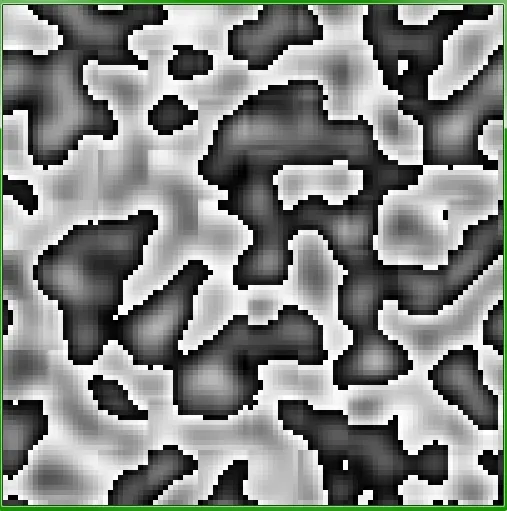我目前正在学习Löve 2d/Lua,并尝试使用Perlin Noise算法生成噪声。
我在此处改编了Ken Perlin的Improved Noise代码:
根据Doug的答案进行修复后编辑的代码
-- original code by Ken Perlin: http://mrl.nyu.edu/~perlin/noise/
perlin = {}
perlin.p = {}
perlin.permutation = { 151,160,137,91,90,15,
131,13,201,95,96,53,194,233,7,225,140,36,103,30,69,142,8,99,37,240,21,10,23,
190, 6,148,247,120,234,75,0,26,197,62,94,252,219,203,117,35,11,32,57,177,33,
88,237,149,56,87,174,20,125,136,171,168, 68,175,74,165,71,134,139,48,27,166,
77,146,158,231,83,111,229,122,60,211,133,230,220,105,92,41,55,46,245,40,244,
102,143,54, 65,25,63,161, 1,216,80,73,209,76,132,187,208, 89,18,169,200,196,
135,130,116,188,159,86,164,100,109,198,173,186, 3,64,52,217,226,250,124,123,
5,202,38,147,118,126,255,82,85,212,207,206,59,227,47,16,58,17,182,189,28,42,
223,183,170,213,119,248,152, 2,44,154,163, 70,221,153,101,155,167, 43,172,9,
129,22,39,253, 19,98,108,110,79,113,224,232,178,185, 112,104,218,246,97,228,
251,34,242,193,238,210,144,12,191,179,162,241, 81,51,145,235,249,14,239,107,
49,192,214, 31,181,199,106,157,184, 84,204,176,115,121,50,45,127, 4,150,254,
138,236,205,93,222,114,67,29,24,72,243,141,128,195,78,66,215,61,156,180
}
perlin.size = 256
perlin.gx = {}
perlin.gy = {}
perlin.randMax = 256
function perlin:load( )
for i=1,self.size do
self.p[i] = self.permutation[i]
self.p[256+i] = self.p[i]
end
end
function perlin:noise( x, y, z )
local X = math.floor(x) % 256
local Y = math.floor(y) % 256
local Z = math.floor(z) % 256
x = x - math.floor(x)
y = y - math.floor(y)
z = z - math.floor(z)
local u = fade(x)
local v = fade(y)
local w = fade(z)
local A = self.p[X+1]+Y
local AA = self.p[A+1]+Z
local AB = self.p[A+2]+Z
local B = self.p[X+2]+Y
local BA = self.p[B+1]+Z
local BB = self.p[B+2]+Z
return lerp(w, lerp(v, lerp(u, grad(self.p[AA+1], x , y , z ),
grad(self.p[BA+1], x-1, y , z )),
lerp(u, grad(self.p[AB+1], x , y-1, z ),
grad(self.p[BB+1], x-1, y-1, z ))),
lerp(v, lerp(u, grad(self.p[AB+2], x , y , z-1),
grad(self.p[BA+2], x-1, y , z-1)),
lerp(u, grad(self.p[AB+2], x , y-1, z-1),
grad(self.p[BB+2], x-1, y-1, z-1))))
end
function fade( t )
return t * t * t * (t * (t * 6 - 15) + 10)
end
function lerp( t, a, b )
return a + t * (b - a)
end
function grad( hash, x, y, z )
local h = hash % 16
local u = h < 8 and x or y
local v = h < 4 and y or ((h == 12 or h == 14) and x or z)
return ((h % 2) == 0 and u or -u) + ((h % 3) == 0 and v or -v)
end
这是我的 Löve 脚本 main.lua:
需要引入 'noise' 库:
function love.load( )
perlin:load()
-- love.graphics.setBackgroundColor(255, 255, 255)
love.window.setMode(500, 500)
end
function love.update( dt )
end
function love.draw( )
for i=1,500 do
for j=1,500 do
local x = perlin:noise(i/10, j/10, 0.3)
love.graphics.setColor(math.floor(x*255), math.floor(x*255), math.floor(x*255))
love.graphics.rectangle("fill", 5*(i-1), 5*(j-1), 5, 5)
end
end
end
我遇到的问题是,与其得到一些伪随机方块的漂亮图像,我得到了一些像这样的渐变条纹: 我很困惑为什么我没有得到通常的噪声渲染。
编辑:这是正常的渲染!

